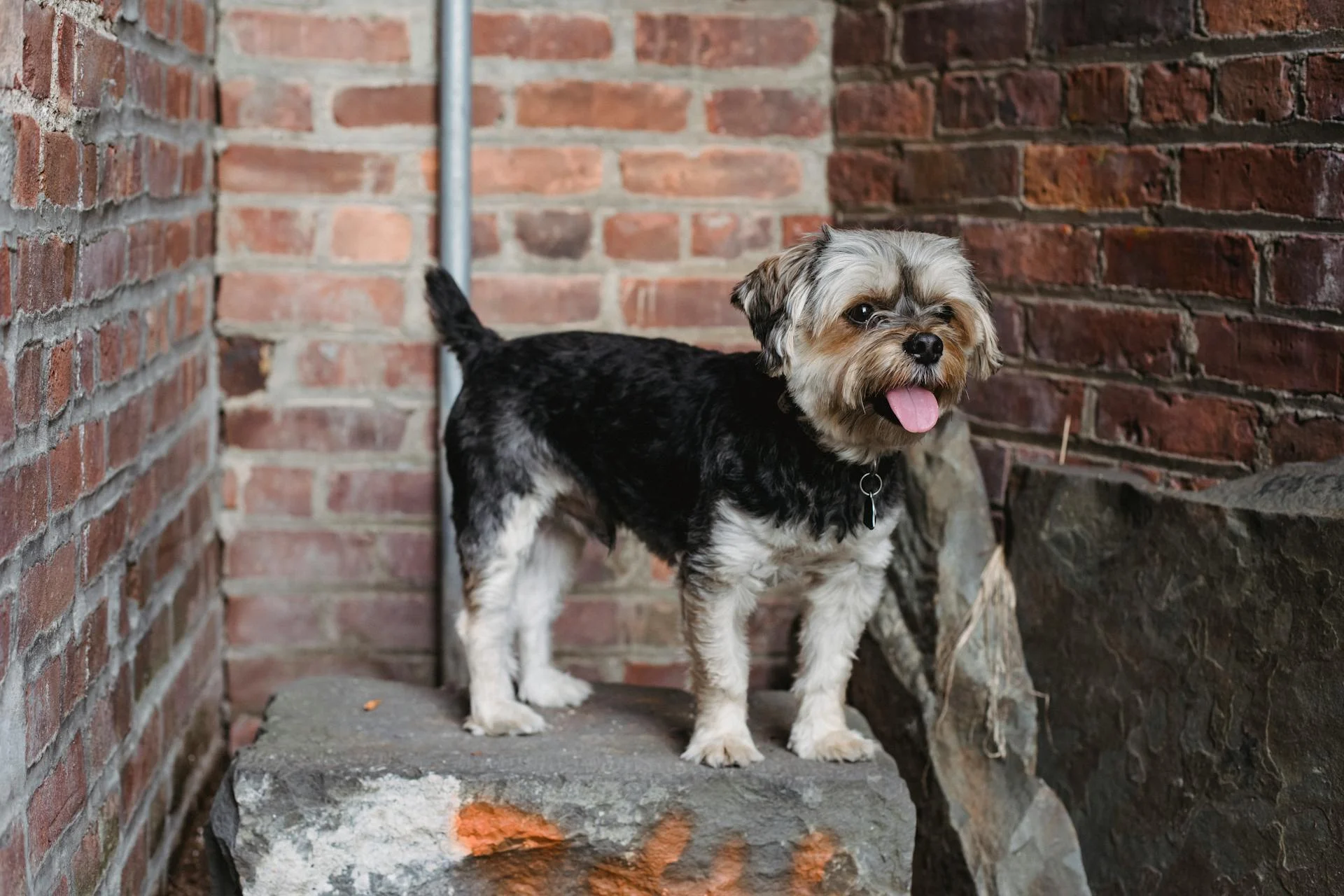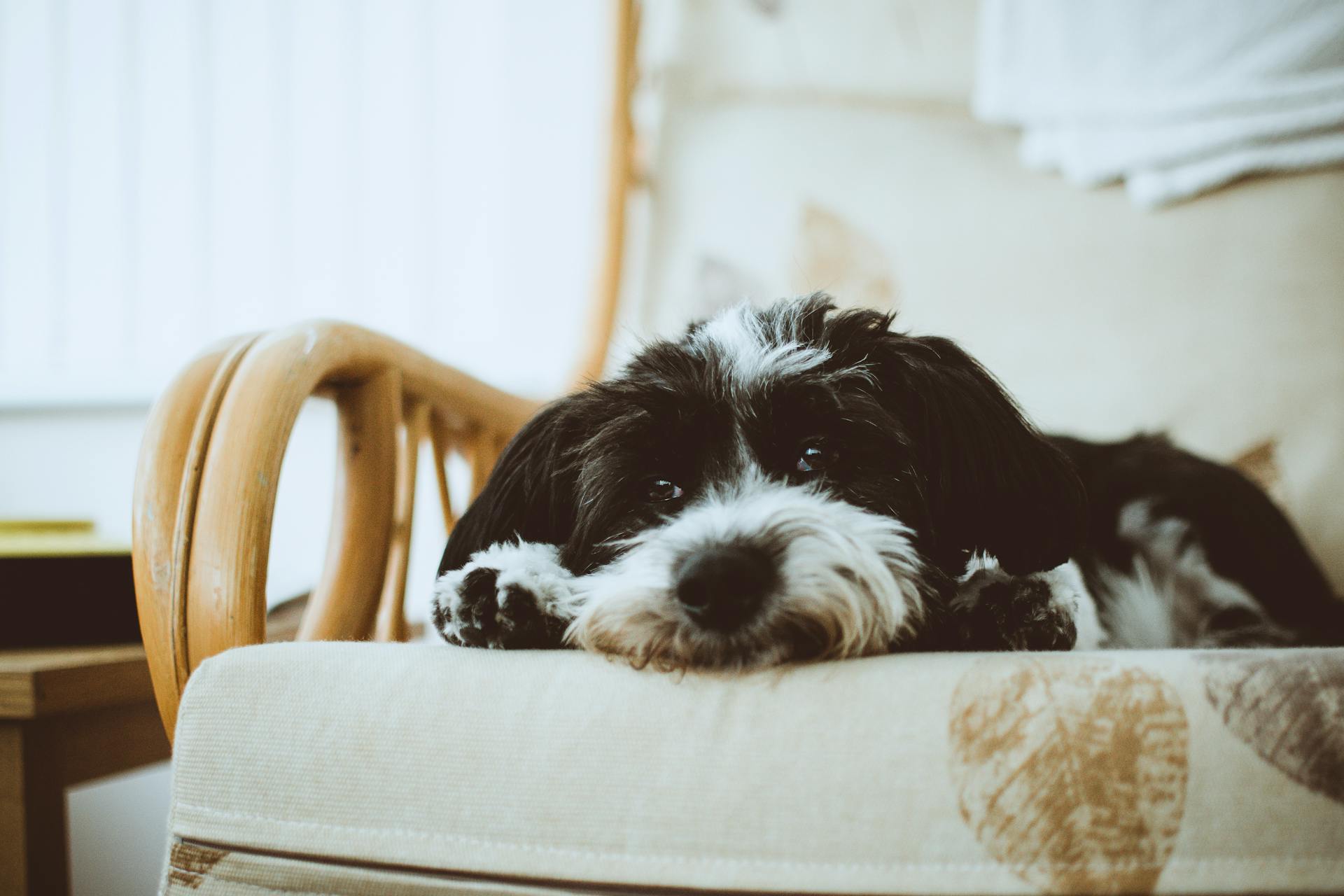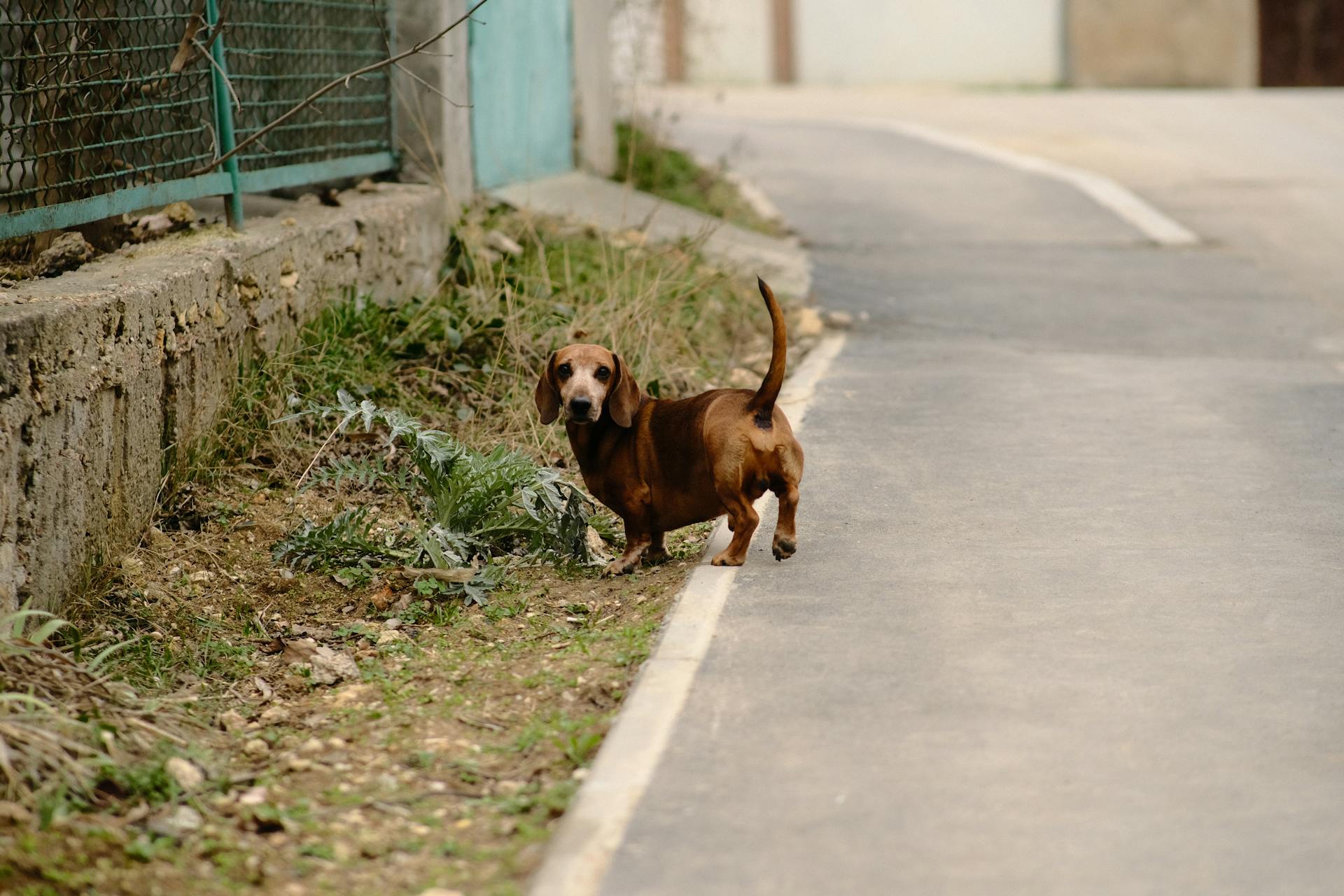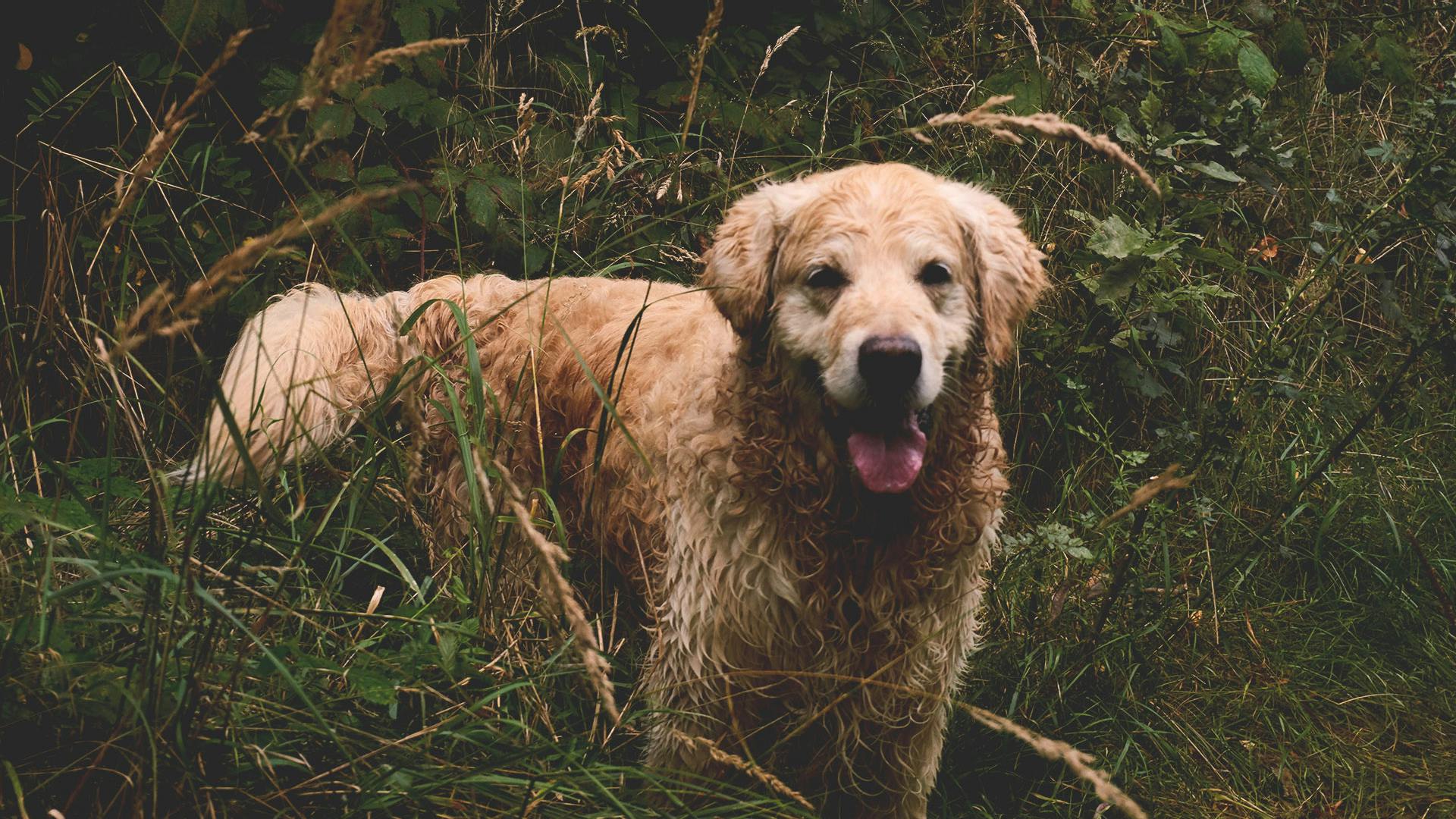
The Havanese Doodle is a cross between a Havanese and a Poodle, typically a Standard Poodle. This breed is often sought after for its low-shedding coat and friendly temperament.
They are generally small to medium-sized dogs, weighing between 7 and 18 pounds. Their height ranges from 8 to 14 inches, making them a great companion for apartment dwellers.
Their coat can vary from wavy to curly, and requires regular grooming to prevent matting. They are also known to be intelligent and trainable, making them a great choice for first-time dog owners.
Their friendly and outgoing personalities make them a great fit for families with children.
A different take: Flat Coat Doodle
Parent Breeds
To get to know a Havanese Doodle, it's essential to learn about each parent breed. This mix is a combination of two highly sought-after breeds, making it exciting but also unpredictable.
The Havanese and Poodle are the parent breeds of the Havanese Doodle. Understanding their needs is crucial in determining what to expect from your Havanese Doodle.
Check this out: Ridgeback Mix Dogs
The Havanese breed is known for its friendly and affectionate nature. They thrive on human interaction and can become destructive if left alone for too long.
Poodles, on the other hand, are intelligent and active dogs that require regular exercise and mental stimulation. They can be high-strung if not provided with enough physical and mental activity.
It's impossible to predict which physical, personality, or mental traits your Havanese Doodle will inherit from its parent breeds.
Temperament
The Havapoo temperament is a wonderful thing. They're smart, friendly, outgoing, playful, and gentle, making them a great match for families with children.
Havapoos are naturally inclined to please their human family, which means they'll want to spend every minute with you. They're also prone to separation anxiety, so they don't do well when left alone for long periods of time.
Their intelligence is one of their best qualities, making them easy to train and quick to learn new tricks. However, this also means they can become mischievous if they don't get enough mental and physical stimulation.
Havapoos are generally very calm and composed, even when provoked, and are known for their patience with small children. They're also great with strangers and other pets, making them a great addition to any family.
Difference Between Havanese and Poo
When considering a Havanese or a Havapoo, one key difference to keep in mind is the texture of their coats. The Havanese has a straighter coat texture than the Havapoo.
Havapoos are more prone to knots and mats, making their coat more high-maintenance. They need to be combed and brushed at least 2-3 times per week.
Their tendency to tangle also makes them less likely to shed, making them a better option for those with allergies.
See what others are reading: Havapoo vs Havanese
Assessing a Dog's Temperament
Temperament is a crucial aspect of a dog's personality, and understanding it is essential for a harmonious human-dog relationship. The Havapoo, a cross between a Havanese and a Poodle, is known for its wonderful personality.
Havapoos are intelligent, friendly, outgoing, playful, and gentle dogs. They are always eager to please and want to spend every minute with their human family. They get along with everyone, including children, adults, strangers, and seniors.
One thing to note is that Havapoos can suffer from separation anxiety, so it's essential to provide them with plenty of attention and interaction. They also need lots of toys, playtime, and exercise to keep them happy and healthy.
Havapoos are highly intelligent dogs that need mental stimulation to prevent boredom and destructive behavior. They can be trained easily, but they can also become independent and mischievous if not provided with enough challenges.
Children and Havapoos are a wonderful match, as they share a passion for games and have a strong bond. However, it's essential to keep an eye on very small children around Havapoos, as they can accidentally hurt them.
Havapoos are also great with other pets, but socialization from an early age is crucial to ensure they get along well with other dogs and animals. They are outgoing and social pups who enjoy spending time with grown-ups and children alike.
In addition to their friendly nature, Havapoos are also gentle and calm, making them an excellent choice for families with small children. They are composed and patient, even when provoked, and are renowned for being great therapy dogs.
Overall, Havapoos are a bundle of energy that wants to be by your side all day. They are people-pleasers, and their sunny disposition makes them a charming and loving companion.
Do Dogs Bark?
Dogs bark for various reasons, but the frequency and volume of barking can vary greatly between breeds and individual dogs.
Most Havapoo dogs are not very loud or prone to barking, but they will alert you to strangers and bark in greeting.
Some Havapoos may be more vocal than others, so it's essential to get to know your dog's unique personality.
Here's an interesting read: Does Havanese Bark a Lot
Coat and Grooming
The Havapoo's coat is a beautiful aspect of this breed, and it's worth understanding what to expect. The Havapoo has a medium-length coat that is usually curly or wavy.
Their coat is quite soft and requires regular grooming to prevent matting and tangling. Routine brushing helps prevent matted hair and keep those beautiful locks looking healthy and luscious.
The Havapoo coat can easily trap in dirt, debris, and dead hair, so daily brushing is a must. Matted hair is a serious health risk, as it can lead to skin irritations and infections.
As a low to non-shedding dog, the Havapoo is a great choice for people who suffer from allergies. However, no dog is 100% hypoallergenic, so it's essential to still take precautions.
Daily brushing can help remove loose hair and prevent matting, making it a great habit to get into.
Explore further: Do Havanese Have Hair or Fur
Coat Colors
The Havapoo's coat colors are quite diverse, with a range of 12 different hues to choose from, including white, black, brown, apricot, silver, blue, chocolate, fawn, gold, gray, and cream.
Their coats can be a single solid color or a combination of two or more colors, often with a white or cream base coat.
The Havapoo's coat color is largely determined by their Poodle and Havanese parent breeds, which can influence the final color and pattern of their coat.
Some Havapoos may have a predominantly white coat with patches of another color, while others may have a solid color with a touch of white or cream.
The variety of coat colors available in the Havapoo breed means that you're likely to find one that suits your personal style and preferences.
Their coat colors can also be influenced by their genetics, with some colors being more dominant than others.
The Havapoo's coat color is just one aspect of their overall appearance, but it's a distinctive feature that sets them apart from other breeds.
A unique perspective: Havanese Cross Breeds
Hair Types
Havapoos can have a variety of hair types, ranging from curly to wavy, and even human-like hair.
Their hair can be thick, soft, and cushy, growing to medium to long length. This is due to the combination of their Poodle and Havanese parent breeds.
Some Havapoos may inherit the Poodle's curly coat, which sheds very minimally, if at all. Others may take after the Havanese parent and have a double coat that sheds slightly more.
Regardless of the hair type, regular brushing is essential to prevent matting and tangling. A daily brush can help keep their beautiful locks looking healthy and luscious.
Matted hair can be a serious health risk, leading to skin irritations and infections. By brushing regularly, you can prevent this from happening and keep your Havapoo looking and feeling their best.
Readers also liked: Havanese Dogs Short Hair
Care and Health
Havapoos are generally a healthy breed, thanks to the benefits of hybrid vigor. They can live for about 10 to 15 years.
To keep your Havapoo healthy, regular grooming is crucial. Brushing their coat at least 2-3 times a week can prevent mats and remove dirt and parasites. You should also brush their teeth daily to prevent dental issues and periodontal disease.
Ear infections are a common issue in Havapoos, so it's essential to check their ears regularly and clean them with dog wet wipes or a damp cloth. Nail clipping every few weeks is also necessary to prevent overgrowth.
Here are some common health issues that can affect Havapoos:
- Hip and elbow dysplasia
- Patellar luxation
- Dental problems
- Eye disorders like progressive retinal atrophy (PRA) and cataracts
- Allergies and sensitivities
- Hypothyroidism
- Epilepsy
- Ear infections
- Deafness
- Addison’s disease
Care
Brushing your Havapoo's coat at least three times a week is essential to prevent matting, especially in the bottom area. Regular brushing will also help prevent hair from getting stuck in feces, which can be painful for your pup.
You'll need to pay close attention to the area around your Havapoo's eyes, as long hair can rub against their eyes and cause irritation. To prevent this, keep their facial hair trimmed regularly.
For more insights, see: Havanese Eyes

Ear infections are a common issue in Havapoos, so it's crucial to keep their ears clean. Trim the hair inside their ear canals and clean their ears regularly to prevent infections.
Regular teeth cleaning is vital for your Havapoo's health. Brush their teeth at least weekly, and consider using a toothbrush specifically designed for dogs.
Nail clipping every few weeks is also essential to prevent overgrowth. You can start clipping your Havapoo's nails when they start making clicking noises on the floor.
Bathing your Havapoo every three weeks to once a month is a good rule of thumb. However, if they get dirty or swim frequently, you may need to bathe them more often.
Using canine-friendly shampoo is crucial, as human shampoo can be harsh on their skin. You can bathe your Havapoo in a laundry sink or shower, and then towel dry and brush their coat while blow-drying.
Brushing your Havapoo's coat at least once a week for a few minutes can help prevent matting and keep their coat clean. Using a bristle brush designed for their coat type is ideal.
Check this out: Cavapoo vs Havapoo

Trimming your Havapoo's coat can be done by a professional, but regular brushing can help prevent matting and keep their coat looking great. Brushing their coat twice to thrice a week is a good starting point.
You'll need to check your Havapoo's ears regularly for signs of infection or debris. Cleaning their ears with dog wet wipes or a damp cloth can help prevent infections.
Brushing your Havapoo's teeth daily with dog toothpaste and a toothbrush specifically designed for dogs can help prevent dental issues. You can start by brushing their teeth with your finger and a little bit of toothpaste.
A fresh viewpoint: Havapoo vs Maltipoo
Health
The Havapoo's health is a bright spot in their overall care and well-being. They enjoy very good health thanks to hybrid vigor.
Their typical life expectancy is around 10 to 15 years, which is a good chunk of time to spend with your furry friend. However, like any other breed, Havapoos can inherit certain health issues from their parental breeds.
If this caught your attention, see: Are Havanese Good with Kids

Some common health concerns in Havapoos include hip and elbow dysplasia, patellar luxation, and dental problems. These issues can be painful and costly to treat, so it's essential to keep an eye out for signs of trouble.
Eye disorders like progressive retinal atrophy and cataracts are also a possibility, as well as allergies and sensitivities. Regular veterinary check-ups can help catch these issues early on.
A healthy diet is crucial for maintaining your Havapoo's overall health. Look for dog food formulas specially made for small breed dogs, as they can be more susceptible to certain health concerns.
Here are some specific health issues that can affect Havapoos:
- Hip and elbow dysplasia
- Patellar luxation
- Dental problems
- Eye disorders like progressive retinal atrophy (PRA) and cataracts
- Allergies and sensitivities
- Hypothyroidism
- Epilepsy
- Ear infections
- Deafness
- Addison's disease
Dog Itchy Rash on Belly
If your furry friend is scratching away at their belly, it's likely due to an itchy rash. This could be caused by food or environmental allergies.
Parasites are another common culprit behind itchy rashes on a dog's belly.
Dog Allergies: Causes, Symptoms, Treatment
Dog allergies are a common struggle for many dogs and poodle mix breeds are no exception.
The causes of dog allergies can be attributed to food or environmental allergies, as well as parasites.
Havapoos, being a cross of a Havanese and a Poodle, may be prone to allergies due to their genetic makeup.
Cataracts, allergies, and skin infections are known health concerns that can arise in Havapoos, with allergies being a common issue.
Symptoms of dog allergies can manifest as itchy rashes on the belly area, among other skin issues.
Treatment for dog allergies often involves addressing the underlying cause, whether it's a food or environmental allergy, and preventing further infections.
Prevention is key, and tips for prevention include regular grooming and maintaining a clean living environment.
On a similar theme: Havanese Food
Size and Growth
Havapoos can weigh anywhere from 6 to 20 pounds, depending on their Poodle genes.
Their height can range from 8 to 15 inches, measured at the shoulders.
It's a wait-and-see situation with mixed breeds, so don't be surprised if your Havapoo grows at a different rate than others in the same litter.
Havapoos tend to reach their full adult size quickly, between 6 to 12 months old.
Here's a breakdown of the typical size estimates for adult Toy and Mini Havapoos:
The size of a Havapoo can vary depending on the size of the Poodle parent used in the mix, with larger Poodles resulting in larger Havapoos.
Training and Behavior
The Havapoo is a highly intelligent breed that thrives on positive reinforcement training. They are easy to train and love to please their owners, making them a great fit for first-time dog owners.
House training and basic commands should be a breeze with a Havapoo, but consistency and patience are key. They can be a bit stubborn at times, so don't give up if they don't pick up a command right away. Treats and praise are essential in keeping them motivated and engaged.
Socialization is also crucial for Havapoos, as they can develop separation anxiety if left alone for too long. Introduce them to new people, dogs, and environments gradually, and make sure they have plenty of toys and playtime to keep them stimulated.
See what others are reading: Havanese Dog Training
86 Responses
Leaving your Havapoo alone can be a challenge, especially if you have a busy schedule. You can leave your Havapoo alone, but it's best to crate-train him.
Crate training is a great way to address separation anxiety in Havapoos, as they are prone to destructive behavior when left alone. Crate training your Havapoo young makes the process easier and gets him used to going to his crate when you leave.
If you don't crate-train your Havapoo, you can expect some destructive behavior when you're away from home. This is because Havapoos are social animals and crave attention and interaction.
Check this out: Havanese Potty Training
Temperament and Behavior
Havapoos are friendly little creatures that are energetic, playful, loving, intelligent, and outgoing.
They are very affectionate and will enjoy spending all of their time with their family, exhibiting great gentleness and intelligence.
Havapoos are great with strangers and wouldn't be hesitant to bond with them in a short while, but they can be less of a watchdog due to this behavior.
They are also very much comfortable with small animals and other dogs, and they are more than happy to spend time with different breeds or any species.
Havapoos have incredible sensitivity to voices, making them a very precious companion.
These dogs are renowned for being patient even with the smallest children in the house, making them a great fit for families with young kids.
Havapoos are also a fantastic fit for seniors, given their affectionate nature and attentiveness.
They have all the best qualities that make up a good therapy dog, being open, receptive, and very aware of what their owners require of them.
Havapoos love playtime with kids, are attention seekers, and adore performing and entertaining the people around them.
Their trick portfolio is impressive and so is their catchy good mood, spreading joy wherever they go.
Havapoos are highly intelligent dogs that love to be mentally stimulated and to learn new tricks, making them easy to train and great companions for first-time pet owners.
Their sunny disposition is one of the breed's most charming traits, and they love nothing more than to cuddle, be the center of attention, and most importantly be with their human family.
Cost and Availability
The Havapoo is a rare and pricey breed, with costs ranging from $2000 to $4000 for a puppy from a reputable breeder. This price tag can be steep, but it's worth it for a healthy and well-cared-for puppy.
In addition to the initial cost of the puppy, you'll also need to factor in the lifelong care of your pet, which can cost between $15,000 and $20,000 over its lifetime. This includes expenses like food, vet bills, and supplies.
Finding a Havapoo breeder can be challenging, especially in the USA and Australia, where the breed is rare. If you're having trouble finding a reputable breeder, you may want to consider looking into rescue options or other similar poodle mix breeds.
Cost Estimate
If you're considering bringing a Havapoo into your family, you'll want to budget accordingly.
The initial cost of a Havapoo from a reputable breeder can range from $2000 to $4000, depending on factors like lineage, coat color, age, and breeder reputation.
Finding a good breeder can be challenging, especially since Havapoos are rare in the USA and Australia.
You'll need to plan for the lifelong care of your pet, which can cost between $15,000 and $20,000 over its lifetime.
Puppy Availability in Australia
The Havapoo is a relatively rare poodle cross breed in Australia. If you're having trouble finding Havanese cross Poodle breeders or puppies for sale near you, consider looking for a rescue or other similar poodle mix breeds.
You can also consider looking at other similar poodle mix breeds such as the Papi-Poo, Bichoodle, Cavoodle, Chi-Poo, Yorki-Poo, PeekaPoo, DoxiePoo, ShihPoo, or Schnoodle.
A fresh viewpoint: Corgis Mixed with Other Breeds
Diet and Nutrition
Havapoo owners know that their dogs require a special diet to stay healthy and happy. Adult Havapoos need food with probiotics for improved digestion and better immunity.
Choosing the right dog food is crucial for your Havapoo's overall health. Look for holistic dog food made with premium ingredients like cage-free poultry, wild fish, or other sustainably raised animal protein sources.
Your Havapoo should get protein, fibre, vitamins, and minerals from their food. The food should also contain vegetables and fruits that are GMO-free so your Havapoo can get all the antioxidants.
As your Havapoo ages, their dietary needs change. Senior Havapoos can benefit from dog food enriched with chondroitin and glucosamine for enhanced joint health.
It's essential to avoid dog food with corn, wheat, fillers, preservatives, and artificial flavours. If you opt for kibble, make sure the pieces are small and easy to pick for your dog's small jaws.
You have the option of feeding your Havapoo a Biologically Appropriate Raw Food Diet (BARF), wet/canned food, or semi-moist food.
Lifespan
The Havanese Doodle's lifespan is a topic that's near and dear to many a dog owner's heart. They can live up to 12-15 years with proper care.
Their size is a contributing factor to their longevity, as smaller breeds tend to live longer than larger ones. This is likely due to the lower risk of health problems associated with smaller frames.
Regular exercise is also crucial for their overall health and happiness. Aim for at least 30 minutes of playtime or walking per day.
For more insights, see: Havanese Dog Health Issues
A balanced diet is essential for maintaining their energy levels and supporting their growth. Feed them high-quality dog food that's suitable for their age and activity level.
Their friendly and outgoing nature makes them a great addition to many families. With proper care and attention, they can thrive in a variety of living situations.
Exercise and Routine
Havapoos, or Havanoodles, need at least an hour of exercise and playtime each day to stay happy and healthy.
Their calm nature doesn't mean they're lazy, so don't expect them to spend all day on the couch.
To avoid behavioral problems, make sure your pup gets plenty of mental and physical stimulation throughout the day.
This means taking them for a walk, playing fetch, or engaging in a fun activity that challenges their mind.
By providing regular exercise and mental stimulation, you'll help your Havapoo develop into a well-rounded adult.
This is especially important for their overall development and to prevent destructive behavior.
You might like: Havanese Feeding Chart
Frequently Asked Questions
Is there a Havanese Poodle mix?
Yes, the Havanese Poodle mix, also known as the Havapoo, is a real hybrid breed. This adorable mix combines the gentle Havanese and intelligent Poodle breeds to create a unique and lovable companion.
How big will a Havapoo get?
A Havapoo typically grows to 18 inches tall and weighs between 7-30 pounds, but size can vary depending on the parent poodle breed.
Featured Images: pexels.com


